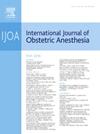乌干达东部一家大型区域转诊医院收治的妇女产后出血的发生率、治疗和结果:一项为期一年的前瞻性观察研究
IF 2.3
3区 医学
Q2 ANESTHESIOLOGY
引用次数: 0
摘要
背景产后出血(PPH)是非洲孕产妇死亡的主要原因。我们研究了乌干达东部一家大型转诊医院PPH的发病率、治疗和结果。方法:这是一项前瞻性观察性研究,纳入了转诊医院产科护理的妇女,以院内PPH为主要结局,院内死亡率为次要结局。随机选取166天,通过直接观察收集数据。采用logistic回归进行多变量分析以确定PPH的危险因素。结果我们招募了22.0%(2358 / 10842)于2021年2月至2022年3月在该医院分娩的妇女;PPH发生率为7.1%(167/2,358),与较高的孕产妇死亡率相关(PPH组为4/167(2.4%),未PPH组为2/2,191 (0.1%);或26.9 [4.9-147.9];P & lt; 0.0001)。在多变量分析中,先兆子痫(OR 2.25 [1.1-4.6];P = 0.027)和双胎妊娠(OR 3.2 [1.7-6.2];P <0.001)与剖宫产时PPH风险增加相关(OR为0.5 [0.3-09];P = 0.009)和4-10 pm之间分娩(OR 0.6 [0.4-0.9];P = 0.032)与风险降低相关。448名妇女(包括281名在其他地方分娩的妇女)接受了PPH治疗;3.3%由产科医生在床边治疗,44.0%可以立即输血,47.0%如果需要则使用氨甲环酸。结论在乌干达一家大型医院分娩的妇女中,每14人中就有1人患PPH。PPH的发病率和死亡率远高于高收入国家。我们的研究结果突出了影响PPH管理的人员短缺和供应链故障。本文章由计算机程序翻译,如有差异,请以英文原文为准。
Incidence, treatment and outcomes of postpartum haemorrhage among women admitted at a large regional referral hospital in eastern Uganda: a one-year prospective observational study
Background
Postpartum haemorrhage (PPH) is the leading cause of maternal mortality in Africa. We studied the incidence, treatment and outcomes of PPH in a large referral hospital in eastern Uganda.
Methods
This was a prospective observational study including women admitted to a referral hospital for obstetric care, with in-hospital PPH as the primary outcome and in-hospital mortality as secondary outcome. Data were collected through direct observation on 166 randomly selected days. Multivariable analysis using logistic regression was conducted to determine risk factors for PPH.
Results
We recruited 22.0% (2,358/10,842) of all women delivering at the hospital from February 2021 to March 2022; PPH rate was 7.1% (167/2,358) and was associated with greater maternal mortality (4/167 (2.4%) with PPH vs. 2/2,191 (0.1%) without PPH; OR 26.9 [4.9–147.9]; P <0.0001). In multivariable analysis, preeclampsia (OR 2.25 [1.1–4.6]; P = 0.027) and twin pregnancy (OR 3.2 [1.7–6.2]; P <0.001) were associated with increased risk of PPH while caesarean delivery (OR 0.5 [0.3–09]; P = 0.009) and delivery between 4–10 pm (OR 0.6 [0.4–0.9]; P = 0.032) were associated with a reduced risk. There were 448 women (including 281 delivered elsewhere) treated for PPH; 3.3% were treated by an obstetrician at the bedside, 44.0% could have immediately received blood and 47.0% tranexamic acid if needed.
Conclusions
One in 14 women delivered at a large Ugandan hospital developed PPH. Rates of PPH and death are far higher than in high-income countries. Our findings highlight staffing shortages and supply chain failures that impact the management of PPH.
求助全文
通过发布文献求助,成功后即可免费获取论文全文。
去求助
来源期刊
CiteScore
4.70
自引率
7.10%
发文量
285
审稿时长
58 days
期刊介绍:
The International Journal of Obstetric Anesthesia is the only journal publishing original articles devoted exclusively to obstetric anesthesia and bringing together all three of its principal components; anesthesia care for operative delivery and the perioperative period, pain relief in labour and care of the critically ill obstetric patient.
• Original research (both clinical and laboratory), short reports and case reports will be considered.
• The journal also publishes invited review articles and debates on topical and controversial subjects in the area of obstetric anesthesia.
• Articles on related topics such as perinatal physiology and pharmacology and all subjects of importance to obstetric anaesthetists/anesthesiologists are also welcome.
The journal is peer-reviewed by international experts. Scholarship is stressed to include the focus on discovery, application of knowledge across fields, and informing the medical community. Through the peer-review process, we hope to attest to the quality of scholarships and guide the Journal to extend and transform knowledge in this important and expanding area.

 求助内容:
求助内容: 应助结果提醒方式:
应助结果提醒方式:


